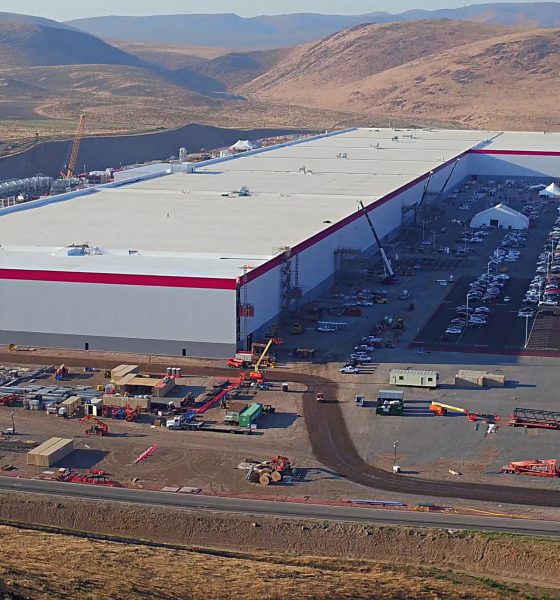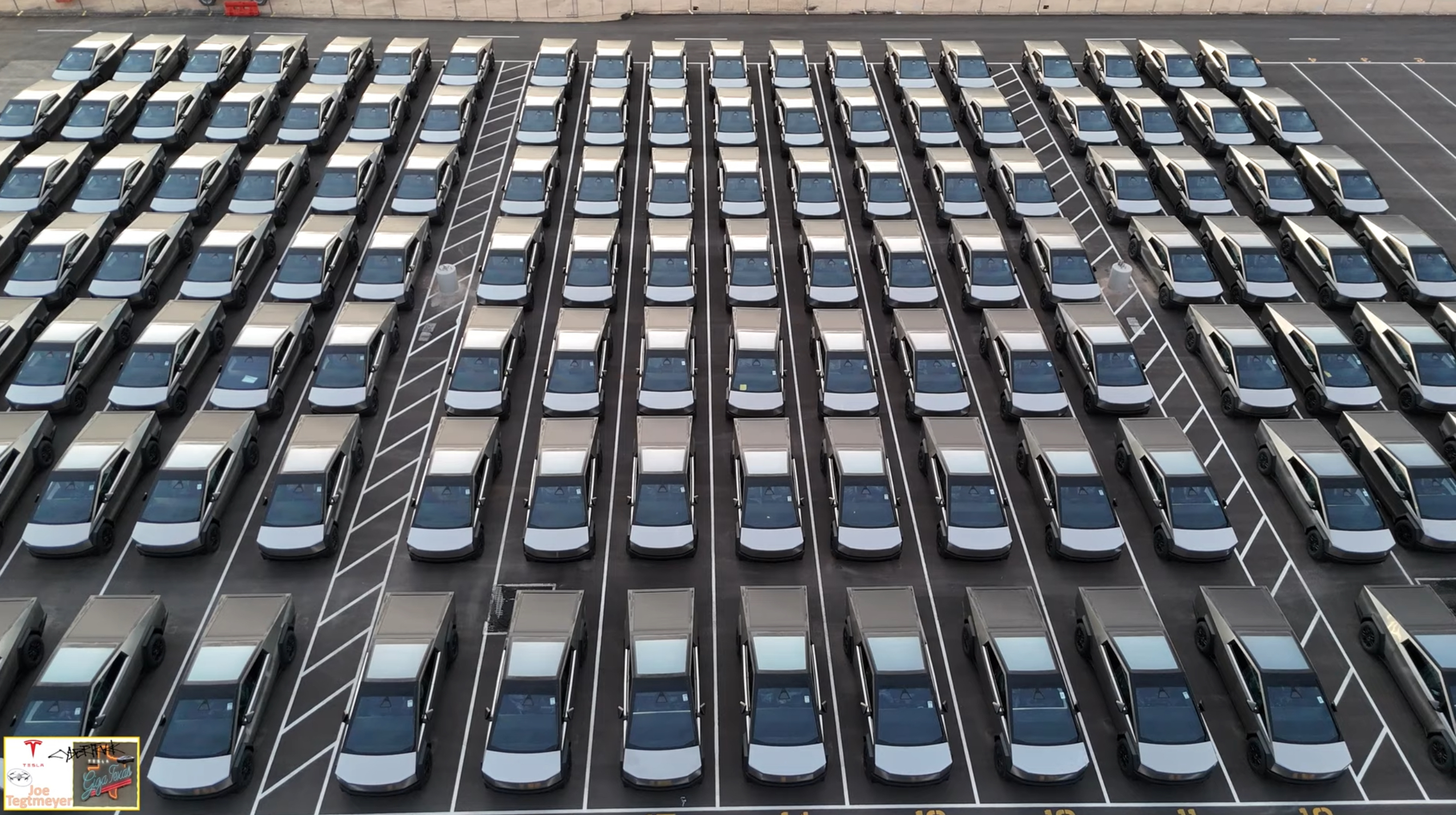

Investor's Corner
Tesla Gigafactory in Nevada tops $1.3 billion in construction costs
Tesla filed 112 new building permits for its Nevada Gigafactory during 2017, with the electric car maker and energy company investing another $379.9 million on the now-$1.3 billion facility.
The new permits filed by the Elon Musk-led firm signified the ongoing development of Gigafactory 1, with Tesla filing a number of addendums to its existing structures and in-house facilities. As noted by BuildZoom, a trend evident in Tesla’s 2017 permits was the high occurrence of project addendums, which correspond to improvements done on facilities that are already in operation.
Over the course of 2017, 50 of the 112 permits filed by the electric car maker and energy firm were addendums to previous structures, including its chiller yard and microgrid lab. Improvements were also implemented for Sections F and G, among others. The overall cost of these updates is valued at $165.6 million.
As revealed by the permits filed by the company in 2017, Tesla opted to add a metrology lab in the Nevada factory. This particular addition is quite notable since metrology equipment is primarily used in the auto industry to ensure that components assembled on the line are built according to precise measurements.
According to a report from Automotive Manufacturing Solutions, metrology equipment are used in car manufacturing to conduct off-line, near-line, and in-line inspections of vehicle components coming off production. These inspections, which are conducted through the utilization of devices such as 3D laser trackers, ultimately improve a car maker’s precision and accuracy when manufacturing parts of a vehicle.
During Tesla’s Q3 2017 earnings report, the California-based firm noted that one of the primary constraints on the production of the mass market vehicle was its battery module assembly line. According to Tesla, the battery modules, which were “done by manufacturing systems suppliers” was significantly “redesigned” by the company, ultimately resulting in a delay in the production of the Model 3. With this in mind, the addition of a metrology lab, which ensures that components produced on-site are manufactured according to specifications, seems to be a step in the right direction.
Other permits that were filed by the California-based electric car company include a brazing oven that automates metal joining, a hot oil skid system that stores and transfers heat fluids, an air separation yard that separates atmospheric air into elemental components, and a chiller yard that removes heat from liquids.
Here are some of the more interesting Tesla Gigafactory project additions in 2017, as noted by BuildZoom
- A metrology lab (November 8, 2017)
- A brazing oven to automate metal joining (November 8, 2017)
- $179,850 for a hazmat building addendum (November 1, 2017)
- $13.7M for hot oil skid systems to store and transfer heat fluids (March 13, 2017)
- $10.8M for air separation yards to separate atmospheric air into elemental components
- $2.6M for chiller yards to remove heat from liquids
Tesla’s Gigafactory seems to be growing from within during the past six months, with most improvements to the facility happening in-house. While external developments along the north and south ends of the factory have remained relatively unchanged since August 2017, the number of permits filed by the car maker during the year prove that Tesla’s efforts in the factory’s improvement have been nothing but consistent.
Once completed, Tesla’s Nevada Gigafactory will be the largest building in the world in terms of physical footprint, with the entire facility set to cover an area of 13 million square feet.

Investor's Corner
Tesla analyst realizes one big thing about the stock: deliveries are losing importance

Tesla analyst Dan Levy of Barclays realized one big thing about the stock moving into 2026: vehicle deliveries are losing importance.
As a new era of Tesla seems to be on the horizon, the concern about vehicle deliveries and annual growth seems to be fading, at least according to many investors.
Even CEO Elon Musk has implied at times that the automotive side, as a whole, will only make up a small percentage of Tesla’s total valuation, as Optimus and AI begin to shine with importance.
He said in April:
“The future of the company is fundamentally based on large-scale autonomous cars and large-scale and large volume, vast numbers of autonomous humanoid robots.”
Almost all of Tesla’s value long-term will be from AI & robots, both vehicle & humanoid
— Elon Musk (@elonmusk) September 11, 2023
Levy wrote in a note to investors that Tesla’s Q4 delivery figures “likely won’t matter for the stock.” Barclays said in the note that it expects deliveries to be “soft” for the quarter.
In years past, Tesla analysts, investors, and fans were focused on automotive growth.
Cars were truly the biggest thing the stock had to offer: Tesla was a growing automotive company with a lot of prowess in AI and software, but deliveries held the most impact, along with vehicle pricing. These types of things had huge impacts on the stock years ago.
In fact, several large swings occurred because of Tesla either beating or missing delivery estimates:
- January 3, 2022: +13.53%, record deliveries at the time
- January 3, 2023: -12.24%, missed deliveries
- July 2, 2024: +10.20%, beat delivery expectations
- October 3, 2022: -8.61%, sharp miss due to Shanghai factory shutdown
- July 2, 2020: +7.95%, topped low COVID-era expectations with sizeable beat on deliveries
It has become more apparent over the past few quarters that delivery estimates have significantly less focus from investors, who are instead looking for progress in AI, Optimus, Cybercab, and other projects.
These things are the future of the company, and although Tesla will always sell cars, the stock is more impacted by the software the vehicle is running, and not necessarily the vehicle itself.
Investor's Corner
SpaceX IPO is coming, CEO Elon Musk confirms
However, it appears Musk is ready for SpaceX to go public, as Ars Technica Senior Space Editor Eric Berger wrote an op-ed that indicated he thought SpaceX would go public soon. Musk replied, basically confirming it.

Elon Musk confirmed through a post on X that a SpaceX initial public offering (IPO) is on the way after hinting at it several times earlier this year.
It also comes one day after Bloomberg reported that SpaceX was aiming for a valuation of $1.5 trillion, adding that it wanted to raise $30 billion.
Musk has been transparent for most of the year that he wanted to try to figure out a way to get Tesla shareholders to invest in SpaceX, giving them access to the stock.
He has also recognized the issues of having a public stock, like litigation exposure, quarterly reporting pressures, and other inconveniences.
However, it appears Musk is ready for SpaceX to go public, as Ars Technica Senior Space Editor Eric Berger wrote an op-ed that indicated he thought SpaceX would go public soon.
Musk replied, basically confirming it:
As usual, Eric is accurate
— Elon Musk (@elonmusk) December 10, 2025
Berger believes the IPO would help support the need for $30 billion or more in capital needed to fund AI integration projects, such as space-based data centers and lunar satellite factories. Musk confirmed recently that SpaceX “will be doing” data centers in orbit.
AI appears to be a “key part” of SpaceX getting to Musk, Berger also wrote. When writing about whether or not Optimus is a viable project and product for the company, he says that none of that matters. Musk thinks it is, and that’s all that matters.
It seems like Musk has certainly mulled something this big for a very long time, and the idea of taking SpaceX public is not just likely; it is necessary for the company to get to Mars.
The details of when SpaceX will finally hit that public status are not known. Many of the reports that came out over the past few days indicate it would happen in 2026, so sooner rather than later.
But there are a lot of things on Musk’s plate early next year, especially with Cybercab production, the potential launch of Unsupervised Full Self-Driving, and the Roadster unveiling, all planned for Q1.
Investor's Corner
Tesla Full Self-Driving statistic impresses Wall Street firm: ‘Very close to unsupervised’
The data shows there was a significant jump in miles traveled between interventions as Tesla transitioned drivers to v14.1 back in October. The FSD Community Tracker saw a jump from 441 miles to over 9,200 miles, the most significant improvement in four years.

Tesla Full Self-Driving performance and statistics continue to impress everyone, from retail investors to Wall Street firms. However, one analyst believes Tesla’s driving suite is “very close” to achieving unsupervised self-driving.
On Tuesday, Piper Sandler analyst Alexander Potter said that Tesla’s recent launch of Full Self-Driving version 14 increased the number of miles traveled between interventions by a drastic margin, based on data compiled by a Full Self-Driving Community Tracker.
🚨 Piper Sandler reiterated its Overweight rating and $500 PT on Tesla $TSLA stock
Analyst Alexander Potter said FSD is near full autonomy and latest versions showed the largest improvement in disengagements, from 440 miles to 9,200 miles between critical interventions pic.twitter.com/u4WCLfZcA9
— TESLARATI (@Teslarati) December 9, 2025
The data shows there was a significant jump in miles traveled between interventions as Tesla transitioned drivers to v14.1 back in October. The FSD Community Tracker saw a jump from 441 miles to over 9,200 miles, the most significant improvement in four years.
Interestingly, there was a slight dip in the miles traveled between interventions with the release of v14.2. Piper Sandler said investor interest in FSD has increased.
Full Self-Driving has displayed several improvements with v14, including the introduction of Arrival Options that allow specific parking situations to be chosen by the driver prior to arriving at the destination. Owners can choose from Street Parking, Parking Garages, Parking Lots, Chargers, and Driveways.
Additionally, the overall improvements in performance from v13 have been evident through smoother operation, fewer mistakes during routine operation, and a more refined decision-making process.
Early versions of v14 exhibited stuttering and brake stabbing, but Tesla did a great job of confronting the issue and eliminating it altogether with the release of v14.2.
Tesla CEO Elon Musk also recently stated that the current v14.2 FSD suite is also less restrictive with drivers looking at their phones, which has caused some controversy within the community.
Although we tested it and found there were fewer nudges by the driver monitoring system to push eyes back to the road, we still would not recommend it due to laws and regulations.
Tesla Full Self-Driving v14.2.1 texting and driving: we tested it
With that being said, FSD is improving significantly with each larger rollout, and Musk believes the final piece of the puzzle will be unveiled with FSD v14.3, which could come later this year or early in 2026.
Piper Sandler reaffirmed its $500 price target on Tesla shares, as well as its ‘Overweight’ rating.








